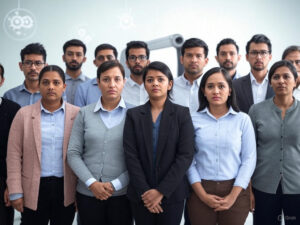Navigating the AI Threats and Opportunities for Indian Jobs
Table of Contents
-
Introduction
-
The AI Revolution in India
-
Segments of Jobs Most at Risk
-
New Jobs and Opportunities Created by AI
-
Why Adaptation is Urgent: Awareness & Threats
-
How to Prepare: Steps for Students, Businesses, and Professionals
-
Conclusion
1. Introduction
Artificial Intelligence (AI) is transforming India at a breathtaking pace. As an Indian business expert and AI visionary, I see both immense opportunities and serious threats. AI is not just a tool for the future-it is already changing the way we work, study, and do business. Those who ignore this change risk being left behind. This article aims to raise awareness about the urgent need to adapt, highlighting which jobs are at risk, what new roles are emerging, and how you can secure your place in the AI-powered future.
2. The AI Revolution in India

-
AI is evolving rapidly in India, with the market expected to grow at a 25–35% CAGR by 20274.
-
68% of white-collar workers fear job automation within five years4.
-
The Indian government and private sector are investing heavily in AI, recognizing its potential to boost productivity and reshape the economy24.
-
However, this transformation brings both opportunities and challenges: while AI will create millions of new jobs, it will also make many current roles obsolete57.
3. Segments of Jobs Most at Risk
AI and automation are set to disrupt several job segments, especially those involving repetitive, rule-based, or low-value tasks. Here’s where the threat is most acute:

A. IT and BPO Sectors
-
Up to 40–50% of white-collar jobs in IT and BPO could be automated, especially roles involving basic coding, software testing, data entry, and customer support368.
-
Entry-level IT jobs, system maintenance, and routine back-office operations are particularly vulnerable68.
B. Manufacturing and Assembly-Line Work
-
Automation and AI-powered robotics are reducing demand for manual labor in textiles, electronics, and automobile assembly lines5.
-
Up to 60 million jobs in manufacturing could be displaced by 2030, especially among low-skilled and semi-skilled workers5.
C. Clerical and Administrative Roles
-
Clerical support, data processing, and basic accounting are at high risk due to AI’s ability to handle large volumes of routine tasks efficiently10.
-
The International Labour Organization estimates that clerical support workers are among the most exposed globally10.
D. Banking and Financial Services
-
Routine tasks in banking-such as loan processing, KYC verification, and compliance checks-are increasingly automated4.
-
High elasticity in financial services means rapid adoption of AI can lead to significant job shifts, though it can also create new roles for those with AI skills4.
E. Retail and Customer Service
-
AI chatbots and automated checkout systems are replacing traditional customer service and cashier roles, especially in large retail chains5.
F. Other Sectors
-
Logistics, transport, and even some healthcare functions (like basic diagnostics and scheduling) are being automated, affecting traditional roles5.
4. New Jobs and Opportunities Created by AI
Despite the risks, AI is also a powerful engine for job creation. Here’s where the new opportunities are emerging:

A. AI and Data Science Roles
-
Data scientists, AI engineers, machine learning specialists, and data analysts are in high demand, commanding salary premiums of 13–17% over traditional roles49.
-
These roles require strong analytical, mathematical, and programming skills.
B. AI Integration and Maintenance
-
Jobs in AI system integration, AI infrastructure management, and AI project management are rapidly growing.
-
Businesses need professionals who can bridge the gap between technical teams and business objectives.
C. Human-AI Collaboration
-
New roles are emerging that focus on working alongside AI-such as AI trainers, explainability experts, and human-in-the-loop supervisors.
-
These jobs require a blend of domain expertise and understanding of AI systems.
D. Cybersecurity and Privacy
-
As AI adoption increases, so does the need for cybersecurity experts and data privacy officers to protect sensitive information.
E. Creative and Strategic Roles
-
AI is automating routine tasks, freeing up people to focus on creative, strategic, and interpersonal roles-like innovation managers, digital marketers, and content creators.
F. AI in Traditional Sectors
-
Agriculture: AI specialists are needed for precision farming, crop monitoring, and agri-tech solutions.
-
Healthcare: Roles in AI-powered diagnostics, telemedicine, and health data analytics are expanding.
-
Education: EdTech professionals are designing personalized learning systems and AI-driven content.
G. Reskilling and Training
-
Demand for trainers, curriculum designers, and educators who can upskill the workforce in AI, digital literacy, and new technologies is soaring5.
5. Why Adaptation is Urgent: Awareness & Threats
A. The Threat is Real and Immediate
-
Up to 40% of roles could be affected by AI globally, with India’s large workforce especially vulnerable38.
-
68% of Indian white-collar workers fear their jobs could be automated within five years4.
-
If you work in a repetitive, rule-based job, you are at risk of being replaced by AI sooner than you think.
B. The “Middle Class Squeeze”
-
Middle and lower wage brackets are most at risk, especially in service-based sectors like IT, BPO, and banking28.
-
Without adaptation, millions could face unemployment or underemployment.
C. The New Skill Divide
-
AI-related jobs offer higher salaries and better prospects, but only for those with the right skills49.
-
Those who do not adapt risk being left behind in low-paying, insecure roles-or worse, out of work entirely.
D. The Window for Change is Closing
-
The transition to an AI-powered economy is happening now. The sooner you adapt, the better your chances of thriving in the new landscape.
6. How to Prepare: Steps for Students, Businesses, and Professionals

A. For Students
-
Choose courses in data science, AI, machine learning, and digital technologies.
-
Develop problem-solving, critical thinking, and creativity-skills that AI cannot easily replicate.
-
Engage in internships and projects that involve AI tools and applications.
B. For Professionals
-
Upskill and reskill: Take online courses, attend workshops, and earn certifications in AI and related fields.
-
Learn to work with AI: Understand how AI can enhance your work, not just replace it.
-
Focus on roles that require human judgment, empathy, and creativity.
C. For Businesses
-
Invest in AI adoption, but also in reskilling your workforce.
-
Identify which roles can be automated and which require human expertise.
-
Foster a culture of continuous learning and innovation.
D. For Policymakers and Educators
-
Update academic curriculums to include AI, data science, and digital literacy2.
-
Create public-private partnerships to provide large-scale reskilling and upskilling programs.
-
Ensure ethical AI deployment and protect workers’ rights during the transition.
7. Conclusion
AI is not just the future-it is the present. In India, the impact will be profound, affecting millions of jobs across sectors. But this is not just a threat; it is also a massive opportunity. Those who adapt, upskill, and embrace AI will find themselves at the forefront of a new era of innovation and prosperity. Those who ignore it risk being left behind.
The message is clear:
If you are a student, professional, or business owner, now is the time to learn about AI, adopt it in your work, and prepare for the future. AI will not wait for you-so don’t wait to adapt. The future belongs to those who are ready.
Take Action Today:
-
Start learning about AI, no matter your background.
-
Encourage your organization to invest in AI and workforce development.
-
Stay curious, stay flexible, and be ready to reinvent yourself for the AI-powered world.
Don’t let AI be a threat-make it your greatest ally.
1 thought on “Navigating the AI Threats and Opportunities for Indian Jobs”